Senna (plant)
| Senna | |
|---|---|

| |
| Senna alexandrina | |
| Scientific classification | |
| Kingdom: | Plantae |
| Clade: | Tracheophytes |
| Clade: | Angiosperms |
| Clade: | Eudicots |
| Clade: | Rosids |
| Order: | Fabales |
| Family: | Fabaceae |
| Subfamily: | Caesalpinioideae |
| Tribe: | Cassieae
|
| Genus: | Senna Mill. |
| Type species | |
| Senna alexandrina | |
| Species | |
|
Over 300; see § Species | |
| Synonyms[1] | |
|
List
| |
Senna, the sennas, is a large
cultivation.[6]
Description
Plants in the genus Senna are shrubs, sometimes small trees or
Systematics
classification is still accepted because a revision of Fabaceae has yet to be published.[11]
The genus Senna has had a complex
Phylogenetic analyses of DNA have shown that Chamaecrista, Cassia, and Senna are all monophyletic, but the relationships between these three genera have not been resolved.[4] They are therefore shown in phylogenetic trees as a tritomy
.
Etymology
The genus name derives from the
Species
As of June 2023[update], Plants of the World Online accepted the following species:[17]




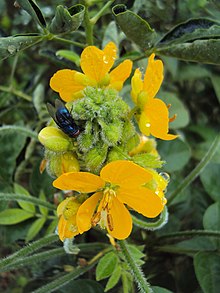
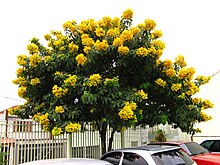
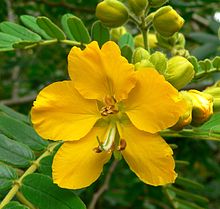

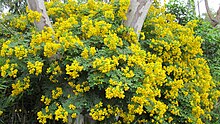
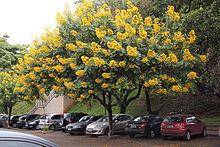
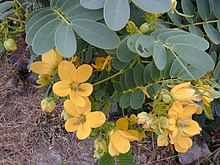
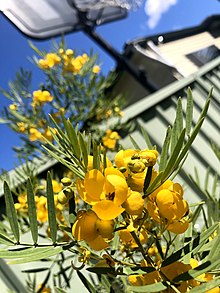
- Senna acanthoclada (Griseb.) H.S.Irwin & Barneby
- Senna acatlanensis C.Rojas-Mart. & A.Delgado
- Senna acclinis (F.Muell.) Randell – rainforest cassia, brush senna (New South Wales)
- Senna aciphylla (Benth. ex A.Gray) Randell – sprawling senna, Australian senna (eastern Australia)
- Senna aculeata (Pohl ex Benth.) H.S.Irwin & Barneby
- Senna acunae (Borhidi) A.Barreto & Yakovlev
- Senna acuparata H.S.Irwin & Barneby
- Senna acuruensis (Benth.) H.S.Irwin & Barneby
- Senna acutisepala (Benth.) H.S.Irwin & Barneby
- Senna affinis (Benth.) H.S.Irwin & Barneby
- Senna alata (L.) Roxb. – candlebush, Christmas candle
- Senna alexandrina Mill. – Alexandrian senna
- Senna andrieuxii (Benth.) H.S.Irwin & Barneby
- Senna angulata (Vogel) H.S.Irwin & Barneby
- Senna angustisiliqua (Lam.) H.S.Irwin & Barneby
- Senna ankaranensis Du Puy & R.Rabev.
- Senna anthoxantha (Capuron) Du Puy
- Senna aphylla (Cav.) H.S.Irwin & Barneby
- Senna apiculata (M.Martens & Galeotti) H.S.Irwin & Barneby
- Senna appendiculata (Vogel) Wiersema
- Senna apsidoneura (H.S.Irwin & Barneby) H.S.Irwin & Barneby
- Senna araucarietorum H.S.Irwin & Barneby
- Senna argentea (Kunth) H.S.Irwin & Barneby
- Senna arida (Rose) H.S.Irwin & Barneby
- Senna aristeguietae H.S.Irwin & Barneby
- Senna armata (S.Watson) H.S.Irwin & Barneby
- Senna arnottiana (Hook.) H.S.Irwin & Barneby
- Senna artemisioides (Gaudich. ex DC.) Randell – silver cassia (Australia)
- Senna atomaria (L.) H.S.Irwin & Barneby
- Senna aurantia (Ruiz & Pav. ex G.Don) H.S.Irwin & Barneby
- Senna auriculata (L.) Roxb. – avaram, Matara-tea, tanner's cassia
- Senna aversiflora (Herb.) H.S.Irwin & Barneby
- Senna aymara H.S.Irwin & Barneby
- Senna baccarinii (Chiov.) Lock
- Senna bacillaris (L.f.) H.S.Irwin & Barneby – West Indian showertree
- Senna bahiensis A.G.Lima & V.C.Souza
- Senna barclayana (Sweet) Randell – smooth senna, pepper-leaf senna (eastern Australia)
- Senna barnebyana Lass.
- Senna barronfieldii (Colla) Hewson – southern cassia (eastern Australia)
- Senna bauhinioides (A.Gray) H.S.Irwin & Barneby
- Senna benitoensis (Britton & P.Wilson) H.S.Irwin & Barneby
- Senna bicapsularis (L.) Roxb. – rambling senna, Christmas bush, money bush, yellow candlewood
- Senna biglandularis A.O.Araujo & V.C.Souza
- Senna birostris (Dombey ex Vogel) H.S.Irwin & Barneby
- Senna bosseri Du Puy & R.Rabev.
- Senna bracteosa D.B.O.S.Cardoso & L.P.Queiroz
- Senna brongniartii (Gaudich.) H.S.Irwin & Barneby
- Senna burkartiana (Villa) H.S.Irwin & Barneby
- Senna cajamarcae H.S.Irwin & Barneby
- Senna cana (Nees & Mart.) H.S.Irwin & Barneby
- Senna candolleana (Vogel) H.S.Irwin & Barneby
- Senna cardiosperma (F.Muell.) Randell (western Australia)
- Senna catingae (Harms) L.P.Queiroz
- Senna caudata (Standl.) H.S.Irwin & Barneby
- Senna cearensis Afr.Fern.
- Senna centranthera H.S.Irwin & Barneby
- Senna cernua (Balb.) H.S.Irwin & Barneby
- Senna chapmanii (Isely) A.Barreto & Yakovlev
- Senna charlesiana (Symon) Randell (Western Australia)
- Senna chloroclada (Harms) H.S.Irwin & Barneby
- Senna chrysocarpa (Desv.) H.S.Irwin & Barneby
- Senna circinnata (Benth.) Randell – coiled senna (eastern Australia)
- Senna cladophylla (W.Fitzg.) Randell (northern Australia)
- Senna clavigera (Domin) Randell – pepper leaf senna (eastern Australia)
- Senna cobanensis (Britton) H.S.Irwin & Barneby
- Senna coimbrae M.Nee & Barneby
- Senna collicola H.S.Irwin & Barneby
- Senna confinis (Greene) H.S.Irwin & Barneby
- Senna corifolia (Benth.) H.S.Irwin & Barneby
- Senna cornigera H.S.Irwin & Barneby
- Senna coronilloides (Benth.) Randell – brigalow senna (eastern Australia)
- Senna corymbosa (Lam.) H.S.Irwin & Barneby – Argentine senna, Argentine wild sensitive plant
- Senna costata (J.F.Bailey & C.T.White) Randell (northern Australia)
- Senna covesii (A.Gray) H.S.Irwin & Barneby – Coues' cassia, Coves' cassia, desert senna
- Senna crassiramea (Benth.) H.S.Irwin & Barneby
- Senna crotalarioides (Kunth) H.S.Irwin & Barneby
- Senna cruckshanksii (Hook.) H.S.Irwin & Barneby
- Senna cuatrecasasii H.S.Irwin & Barneby
- Senna cumingii (Hook. & Arn.) H.S.Irwin & Barneby
- Senna curvistyla (J.M.Black) Randell (north-western Australia)
- Senna cushina (J.F.Macbr.) H.S.Irwin & Barneby
- Senna cuthbertsonii (F.Muell.) Randell (northern Western Australia)
- Senna dardanoi Afr.Fern. & P.Bezerra
- Senna dariensis (Britton & Rose) H.S.Irwin & Barneby
- Senna davidsonii (V.Singh) V.Singh
- Senna demissa (Rose) H.S.Irwin & Barneby
- Senna didymobotrya (Fresen.) H.S.Irwin & Barneby – candelabra-tree, peanut butter cassia, African senna
- Senna divaricata (Nees & Blume) Lock
- Senna domingensis (Spreng.) H.S.Irwin & Barneby
- Senna durangensis (Rose) H.S.Irwin & Barneby
- Senna ellisiae (Brenan) Lock
- Senna ferraria (Symon) Randell (north-western Western Australia)
- Senna flexuosa (Randell) Randell (Western Australia)
- Senna foetidissima (Ruiz & Pav. ex G.Don) H.S.Irwin & Barneby
- Senna formosa H.S.Irwin & Barneby
- Senna fruticosa (Mill.) H.S.Irwin & Barneby
- Senna galeottiana (M.Martens) H.S.Irwin & Barneby
- Senna gardneri (Benth.) H.S.Irwin & Barneby
- Senna garrettiana (Craib) H.S.Irwin & Barneby
- Pacific Islands, Queensland)
- Senna georgica H.S.Irwin & Barneby
- Senna glanduligera (H.St.John) A.C.Sm.
- Senna glaucifolia (Randell) Randell (north-western Australia)
- Senna glutinosa (DC.) Randell (Australia)
- Senna goniodes (A.Cunn. ex Benth.) Randell (northern Western Australia)
- Senna gossweileri (Baker f.) Lock
- Senna guatemalensis (Donn.Sm.) H.S.Irwin & Barneby
- Senna gundlachii (Urb.) H.S.Irwin & Barneby
- Senna hamersleyensis (Symon) Randell – creeping senna (northern Western Australia)
- Senna harleyi H.S.Irwin & Barneby
- Senna haughtii (J.F.Macbr.) H.S.Irwin & Barneby
- Senna hayesiana (Britton & Rose) H.S.Irwin & Barneby
- Senna hebecarpa (Fernald) H.S.Irwin & Barneby – American senna, wild senna
- Senna heptanthera Randell (Arnhem Land)
- Senna herzogii (Harms) H.S.Irwin & Barneby
- Senna hilariana (Benth.) H.S.Irwin & Barneby
- Senna hirsuta (L.) H.S.Irwin & Barneby – woolly senna (native to Americas, introduced elsewhere)
- Senna holosericea (Fresen.) Greuter
- Senna holwayana (Rose) H.S.Irwin & Barneby
- Senna hookeriana Batke
- Senna huancabambae (Harms) H.S.Irwin & Barneby
- Senna huidobriana (Phil.) Zoellner & San Martin
- Senna huilana (Britton & Rose) H.S.Irwin & Barneby
- Senna humifusa (Brenan) Lock
- Senna incarnata (Benth.) H.S.Irwin & Barneby
- Senna insularis (Britton & Rose) H.S.Irwin & Barneby
- Senna intermedia (B.D.Sharma, Vivek. & Rathakr.) V.Singh
- Senna italica Mill. – Port Royal senna, dog senna, Italian senna, Spanish senna
- Senna itatiaiae H.S.Irwin & Barneby
- Senna juchitanensis Saynes & R.Torres
- Senna koelziana H.S.Irwin & Barneby
- Senna kuhlmannii Hoehne
- Senna kurtzii (Harms) H.S.Irwin & Barneby
- Senna lactea (Vatke) Du Puy
- Senna lasseigniana H.S.Irwin & Barneby
- Senna latifolia (G.Mey.) H.S.Irwin & Barneby
- Senna leandrii (Ghesq.) Du Puy
- Senna lechriosperma H.S.Irwin & Barneby
- Senna leiophylla (Vogel) H.S.Irwin & Barneby
- Senna leptoclada (Benth.) Randell (Northern Territory)
- Senna ligustrina (L.) H.S.Irwin & Barneby – privet senna
- Senna lindheimeriana (Scheele) H.S.Irwin & Barneby – velvet-leaf senna, showy senna
- Senna longiglandulosa (Benth.) H.S.Irwin & Barneby
- Senna longiracemosa (Vatke) Lock
- Senna loretensis (Killip) H.S.Irwin & Barneby
- Senna lourteigiana H.S.Irwin & Barneby
- Senna macranthera (DC. ex Collad.) H.S.Irwin & Barneby
- Senna macrophylla (Kunth) H.S.Irwin & Barneby
- Senna magnifolia (F.Muell.) Randell (Western Australia)
- Senna malaspinae H.S.Irwin & Barneby
- Senna mandonii (Benth.) H.S.Irwin & Barneby
- Senna manicula (Symon) Randell (Western Australia)
- Senna marilandica (L.) Link
- Senna martiana (Benth.) H.S.Irwin & Barneby
- Senna mensicola (H.S.Irwin & Barneby) H.S.Irwin & Barneby
- Senna meridionalis (R.Vig.) Du Puy – Madagascar senna
- Senna mexicana (Jacq.) H.S.Irwin & Barneby – Mexican senna
- Senna mollissima (Humb. & Bonpl. ex Willd.) H.S.Irwin & Barneby
- Senna monilifera H.S.Irwin & Barneby
- Senna monozyx (H.S.Irwin & Barneby) H.S.Irwin & Barneby
- Senna montana (B.Heyne ex Roth) V.Singh
- Senna morongii (Britton) H.S.Irwin & Barneby
- Senna mucronifera (Mart. ex Benth.) H.S.Irwin & Barneby
- Senna multifoliolata (Paul G.Wilson) H.S.Irwin & Barneby
- Senna multiglandulosa (Jacq.) H.S.Irwin & Barneby – glandular senna, downy senna (Central and Southern America, introduced elsewhere)
- Senna multijuga (Rich.) H.S.Irwin & Barneby – November shower, false sicklepod (Central and Southern America, introduced elsewhere)
- Senna mutisiana (Kunth) H.S.Irwin & Barneby
- Senna nana (Benth.) H.S.Irwin & Barneby
- Senna neglecta (Vogel) H.S.Irwin & Barneby
- Senna nicaraguensis (Benth.) H.S.Irwin & Barneby
- Senna nitida (Rich.) H.S.Irwin & Barneby
- Senna notabilis (F.Muell.) Randell – cockroach bush (Australia)
- Senna nudicaulis (Burkart) H.S.Irwin & Barneby
- Senna obliqua (G.Don) H.S.Irwin & Barneby (Peru)
- Senna oblongifolia (Vogel) H.S.Irwin & Barneby
- Senna obtusifolia (L.) H.S.Irwin & Barneby – coffee-weed, java-bean, American sicklepod (Central and Southern America, introduced elsewhere)
- Senna occidentalis (L.) Link – coffee senna, styptic weed, septicweed (U.S.A., Central and Southern America, introduced elsewhere)
- Senna oligoclada (F.Muell.) Randell (Northern Australia)
- Senna orcuttii (Britton & Rose) H.S.Irwin & Barneby – Orcutt's senna
- Senna organensis (Glaz. ex Harms) H.S.Irwin & Barneby
- Senna oxyphylla (Kunth) H.S.Irwin & Barneby
- Senna pachyrrhiza (L.Bravo) H.S.Irwin & Barneby
- Senna pallida (Vahl) H.S.Irwin & Barneby
- Senna papillosa (Britton & Rose) H.S.Irwin & Barneby
- Senna paposana (Phil.) Zoellner & San Martin
- Senna paradictyon (Vogel) H.S.Irwin & Barneby
- Senna paraensis (Ducke) H.S.Irwin & Barneby
- Senna pendula (Humb. & Bonpl. ex Willd.) H.S.Irwin & Barneby – Easter cassia
- Senna pentagonia (Mill.) H.S.Irwin & Barneby
- Senna peralteana (Kunth) H.S.Irwin & Barneby
- Senna perrieri (R.Vig.) Du Puy
- Senna petersiana (Bolle) Lock
- Senna phlebadenia H.S.Irwin & Barneby
- Senna phyllodinea (R.Br.) Symon (arid areas of Australia)
- Senna pilifera (Vogel) H.S.Irwin & Barneby
- Senna pilocarina (Symon) Randell (Western Australia)
- Senna pilosior (B.L.Rob.) H.S.Irwin & Barneby — Trans-Pecos senna
- Senna pinheiroi H.S.Irwin & Barneby
- Senna pistaciifolia (Kunth) H.S.Irwin & Barneby
- Senna planitiicola (Domin) Randell
- Senna pleurocarpa (F.Muell.) Randell – stripe-pod cassia
- Senna pleuribracteata F.S.Souto & R.T.Queiroz
- Senna pneumatica H.S.Irwin & Barneby
- Senna podocarpa (Guill. & Perr.) Lock
- Senna polyantha (Collad.) H.S.Irwin & Barneby
- Senna polyphylla (Jacq.) H.S.Irwin & Barneby
- Senna praeterita H.S.Irwin & Barneby
- Senna procumbens Randell
- Senna pumilio (A.Gray) H.S.Irwin & Barneby – dwarf senna
- Senna punoensis Lass.
- Senna purpusii (Brandegee) H.S.Irwin & Barneby
- Senna quinquangulata (Rich.) H.S.Irwin & Barneby
- Senna racemosa (Mill.) H.S.Irwin & Barneby – limestone senna
- Senna reniformis (G.Don) H.S.Irwin & Barneby
- Senna reticulata (Willd.) H.S.Irwin & Barneby
- Senna rigidicaulis (Burkart ex L.Bravo) H.S.Irwin & Barneby
- Senna ripleyana (H.S.Irwin & Barneby) H.S.Irwin & Barneby – Ripley's senna
- Senna rizzinii H.S.Irwin & Barneby
- Senna robiniifolia (Benth.) H.S.Irwin & Barneby
- Senna roemeriana (Scheele) H.S.Irwin & Barneby – twoleaf senna, Roemer senna
- Senna rostrata (Mart.) H.S.Irwin & Barneby – New Mexico wild sensitive plant
- Senna rugosa (G.Don) H.S.Irwin & Barneby
- Senna ruiziana (G.Don) H.S.Irwin & Barneby
- Senna rupununiensis H.S.Irwin & Barneby
- Senna ruspolii (Chiov.) Lock
- Senna saeri (Pittier) H.S.Irwin & Barneby
- Senna sandwithiana H.S.Irwin & Barneby
- Senna santanderensis (Britton & Killip) H.S.Irwin & Barneby
- Senna scabriuscula (Vogel) H.S.Irwin & Barneby
- Senna scandens (G.Don) H.S.Irwin & Barneby
- Senna septemtrionalis (Viv.) H.S.Irwin & Barneby – arsenic-bush, dooleyweed, laburnum, smooth senna
- Senna sericea (Symon) Albr. & Symon
- Senna siamea (Lam.) H.S.Irwin & Barneby – kassodtree, Siamese cassia, Thai cassia, Thailand shower
- Senna silvestris (Vell.) H.S.Irwin & Barneby
- Senna singueana (Delile) Lock
- Senna skinneri (Benth.) H.S.Irwin & Barneby
- Senna smithiana (Britton & Rose) H.S.Irwin & Barneby
- Senna sophera (L.) Roxb.
- Senna sousana H.S.Irwin & Barneby
- Senna spectabilis (DC.) H.S.Irwin & Barneby
- Senna spinescens (Hoffmanns. ex Vogel) H.S.Irwin & Barneby
- Senna spiniflora (Burkart) H.S.Irwin & Barneby
- Senna spinigera (Rizzini) H.S.Irwin & Barneby
- Senna splendida (Vogel) H.S.Irwin & Barneby
- Senna stenophylla (Britton) H.S.Irwin & Barneby
- Senna stipulacea (Aiton) H.S.Irwin & Barneby
- Senna stowardii (S.Moore) Randell
- Senna stricta (Randell) Randell
- Senna suarezensis (Capuron) Du Puy
- Senna subtrijuga H.S.Irwin & Barneby
- Senna subulata (Griseb.) H.S.Irwin & Barneby
- Senna sulfurea (DC. ex Collad.) H.S.Irwin & Barneby
- Senna surattensis (Burm.f.) H.S.Irwin & Barneby
- Senna symonii (Randell) Randell
- Senna talpana H.S.Irwin & Barneby
- Senna tapajozensis (Ducke) H.S.Irwin & Barneby
- Senna tenuifolia (Vogel) H.S.Irwin & Barneby
- Senna timoriensis (DC.) H.S.Irwin & Barneby
- Senna tocotana (Rose ex Britton & Killip) Silverst.
- Senna tonduzii (Standl.) H.S.Irwin & Barneby
- Senna tora (L.) Roxb. – sickle senna, foetid cassia
- Senna trachypus (Mart. ex Benth.) H.S.Irwin & Barneby
- Senna trianae H.S.Irwin & Barneby
- Senna trolliiflora H.S.Irwin & Barneby
- Senna tropica (Vell.) H.S.Irwin & Barneby
- Senna truncata (Brenan) Lock
- Senna tuhovalyana (Aké Assi) Lock
- Senna uncata H.S.Irwin & Barneby
- Senna undulata (Benth.) H.S.Irwin & Barneby
- Senna uniflora (Mill.) H.S.Irwin & Barneby
- Senna unijuga (Rose) H.S.Irwin & Barneby
- Senna urmenetae (Phil.) H.S.Irwin & Barneby
- Senna vargasii (Schery) H.S.Irwin & Barneby
- Senna velutina (Vogel) H.S.Irwin & Barneby
- Senna venusta (F.Muell.) Randell
- Senna versicolor (Meyen ex Vogel) H.S.Irwin & Barneby
- Senna viarum (Little) H.S.Irwin & Barneby
- Senna viciifolia (Benth.) H.S.Irwin & Barneby
- Senna viguierella (Ghesq.) Du Puy
- Senna villosa (Mill.) H.S.Irwin & Barneby
- Senna viminea (L.) H.S.Irwin & Barneby
- Senna weddelliana H.S.Irwin & Barneby
- Senna williamsii (Britton & Rose) H.S.Irwin & Barneby
- Senna wislizeni (A.Gray) H.S.Irwin & Barneby
- Senna wurdackii H.S.Irwin & Barneby – Wislizenus' senna, shrubby senna
Ecology
The
Astraptes fulgerator), common emigrant (Catopsilia pomona), and mottled emigrant (C. pyranthe) have all been recorded on candle bush (S. alata
), for example.
Some species have
extrafloral nectaries on the leaves or flower stalks that are visited by ants.[4]
Pollination
Senna species are
Xylocopa.[4] They rely on "buzz pollination" and some within that on "ricochet pollination", which is a secondary pollen presentation where the pollen is not deposited on the pollinator's body by direct contact with the anthers.[18] The flowers have two sets of stamen: feeding stamens, which are longer, and pollinating stamens, which are smaller in size.[19] Due to buzz pollination, the pollens from the pollinating stamens get thrown from the anthers and ricochets against the petals multiple times before it settles on the dorsal side of the pollinating bee. The roughness on the petal walls causes the pollen to slow down its speed. The ricocheting effect alone cannot ensure effective pollen dissemination. It is aided by static charges wherein the flying bees become positively charged owing to the friction in the air and the pollen becomes negatively charged because of which they naturally get attracted to the bees body. The pollinator bee ends up carrying the pollen and also gets to feed on the pollen which is on the feeding stamens.[18]
Uses
Some Senna species are used as
adapted to many climate
types.
Southeast Asian cuisines, such as Thai, Shan/Burmese and Lao cuisines. They are known as khi-lek in Thai, and are used in curries.[20]
Laxative
Senna is considered to be a
peristaltic contractions and decrease water absorption from inside the colon, effects that would provide relief from constipation.[21] The laxative syrup of figs gets most of its effect from the presence of senna.[22]
Plants in the Senna genus have been studied for their beneficial effects arising from the abundance of phytochemicals, bioactive components and antioxidant and antimicrobial properties.[3]
Senna or its extracted
Cochrane reviews for treatment of constipation in children and the elderly. Some studies showed limited evidence for efficacy,[23][24][25] whereas others indicated the study designs were too weak to be certain of senna having utility as a laxative.[21][26][27]
Fossil record
This section needs expansion. You can help by adding to it. (April 2019) |
A
Eocene epoch has been described from the Rancho clay pit in Henry County, Tennessee (United States).[28]
References
- .
- hdl:10568/90658.
- ^ PMID 35154569.
- ^ S2CID 24791422.
- Randell, B. R.and B. A. Barlow. 1998. Senna. pp 89-138. In: A. S. George (executive editor). Flora of Australia volume 12. Australian Government Publishing Service: Canberra, Australia.
- ISBN 978-0-333-47494-5(set).
- ^ "Senna". Australian Biological Resources Study, Department of Agriculture, Water and the Environment: Canberra. Retrieved 3 June 2023.
- ^ Jeanes, Jeff A.; Stajsic, Val. "Senna". Royal Botanic Gardens Victoria. Retrieved 3 June 2023.
- ^ Wiecek, Barbara. "Senna". Royal Botanic Garden Sydney. Retrieved 3 June 2023.
- ^ "Senna". Flora of China. Retrieved 3 June 2023.
- ^ ISBN 978-1-900347-80-8
- ^ Irwin H. S., Barneby R. C. (1982). "The American Cassiinae: A synoptical revision of Leguminosae tribe Cassieae subtribe Cassiinae in the New World". Memoirs of the New York Botanical Garden. 35: 1–119.
- ^ Singh, V. 2001. Monograph on the Indian Subtribe Cassiinae. Scientific Publishers (India): Jodhpur, India.
- ^ Linnaeus, C. 1753. Cassia. page 376. In: Species Plantarum volume 1. Cassia (including Senna) In:Species Plantarum volume 1 At: Biodiversity Heritage Library
- ^ Miller, P. 1754. The Gardeners Dictionary, Abridged 4th edition.
- ^ "Senna". Australian Biological Resources Study, Department of Agriculture, Water and the Environment: Canberra. Retrieved 1 June 2023.
- ^ "Senna". Plants of the World Online. Retrieved 1 June 2023.
- ^ ISBN 9780429960710.
- doi:10.1590/0102-33062018abb0132.)
{{cite journal}}: CS1 maint: multiple names: authors list (link - ^ Teangpook C.; et al. (2011). "Production and nutrition of Khi Lek (Siamese cassia) curry from central Thailand" (PDF). Kasetsart. J. (Nat. Sci.). 45: 510–20. Archived from the original (PDF) on 2016-03-04. Retrieved 2013-08-29.
- ^ PMID 21737769.
- ^ Lockhart, Bill; Schriever, Beau. "California Fig Syrup: The Company and Its Bottles" (PDF). Society for Historical Archaeology. Retrieved 2022-01-01.
- PMID 21418672.
- PMID 26757467.
- PMID 27158549.
- PMID 25535635.
- PMID 27531591.
- ISBN 0 947643 40 0
